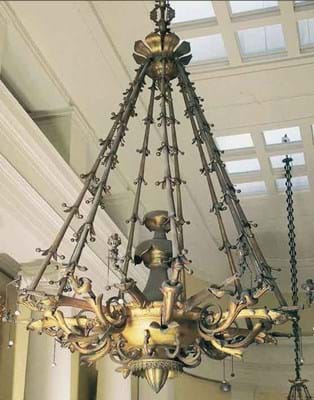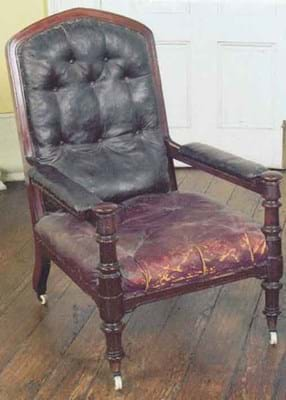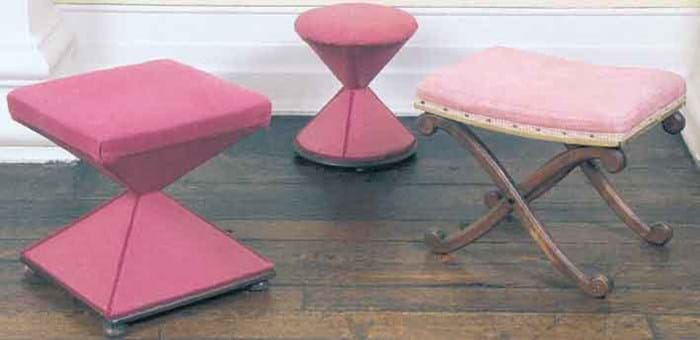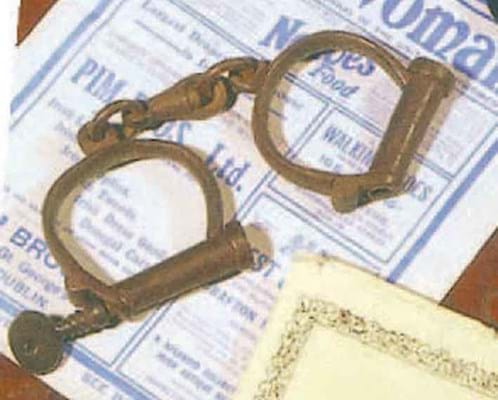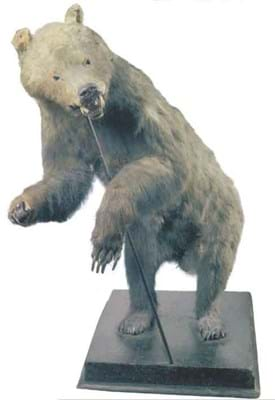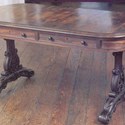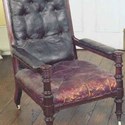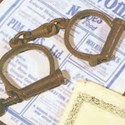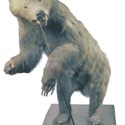On an art-historical level, the dilapidated Grecian-style mansion designed for Sir Robert Gore-Booth by the fashionable English architect Francis Goodwin (1784-1835) is a unique conceit, retaining so much of its original decor. On an emotional level, this is a house where Yeats stayed and wrote, and the childhood home of Sinn Fein heroine Constance Gore-Booth and her poet sister Eva Gore-Booth.
A report was commissioned by the Irish Government and its verdict suggested the overall cost of purchasing Lissadell and refurbishing it as a major visitor attraction would be in the region of €28m (£19.5m).
The idea of a State purchase of house and contents close to the asking price of €4.5m (£3.15m) was rejected and, shortly afterwards, the estate was sold privately to barristers Edward Walsh and his wife Constance Cassidy for around €3.5m (£2.5m).
Christie's and Dublin-based auctioneers Hamilton Osbourne King Fine Art were asked to prepare a catalogue as joint agents for the sale.
The auctioneers found themselves knee-deep in a controversy surrounding the sale of a Grade I listed property and so many of its original furnishings, but here was the opportunity to sell elements from a uniquely preserved interior.
Vendor Sir Josslynn Gore-Booth had lived comfortably in the property within a sophisticated flat but had left the rest of the house much as it was in the second quarter of the 19th century.
That included a remarkable array of bespoke William IV period mahogany and rosewood furniture by leading Dublin cabinetmakers Williams & Gibton and seven spectacular ormolu gasoliers from the first country house in Ireland to be lit by gas that were quickly to bring all parties up-to-date with recent guidelines laid out by the Republic's Department of the Environment.
Although during preparations for the sale on November 25 the auctioneers had gained initial approval from Sligo Council on the grounds that the light fittings were not part of the architect's original vision for the property, An Taisce, the Irish National Trust, challenged their sale under new legislation in Ireland regarding fixtures and fittings of listed buildings.
Using guidelines laid out by the Department of the Environment in 2001, An Taisce argued that the gasoliers were of "technical importance", given Lissadell's status as the first country house in Ireland to have an independent gas supply piped into the property during the construction of the building in the early 1830s.
While the spectacular lights were not part of the building upon its completion in 1833 (none is present in Francis Goodwin's View of the Gallery at Lissadell,published as the frontispiece to hisDomestic Architecture, 1833-34) they were introduced only shortly afterwards perhaps in 1834. They were also likely commissioned from William Collins of The Strand specifically for the property and now, argued An Taisce, make a significant contribution to the architectural character of the building.
An Taisce, who in August had put together a proposal to acquire and manage Lissadell for the people of Ireland, also opposed the sale of a mahogany and parcel gilt chamber organ by Hull of Dublin on the grounds that its bellows system ran down to the basement making it an integral part of the fabric of the building.
It had the making of an interesting case (the first to test the new laws in court) but the legal action was dropped as the matter reached a happy conclusion. The light fittings and the organ will remain in Lissadell after an eleventh-hour deal was struck between the new owners of the property and the vendor Sir Josslynn Gore-Booth.
Furniture
But if, as it turned out, the light fittings couldn't be offered on the market, then the furniture could. In Ireland at least, the law can't be extended to include moveable objects.
Prior to this sale, as the auctioneers announced proudly in the catalogue, Lissadell remained the only house in Ireland still to retain its original Williams & Gibton furniture and much of it was made to harmonise with Goodwin's architectural vision.
Pieces included, for example, a handsome pair of mahogany bookcases, each of inverted breakfront form with a pair of brass floral trellis doors and a heavy cornice flanked by two Egyptian pillars with long doors applied with berried laurel wreaths. Originally conceived to complement similar decoration with the chimneypiece and ceiling of the ante room, they were unfortunately made to room measurements taken prior to the completion of the plasterwork. Accordingly this was bespoke furniture that didn't quite fit.
Nevertheless, they have been in the drawing room since the 1830s and they will remain there, having been bought by the new owners of the property who bid €45,000 (£31,470) for them.
Much to the satisfaction of those who had fought hard to prevent this sale and the sale of the house, Edward Walsh and Constance Cassidy (who had been rebuffed by Gore-Booth when they had put €750,000 (£525,000) on the table for the contents) bid prominently in the room to win most of the items with a key relationship with the history and the architecture of the house.
The one exception was a double portrait of Constance and Eva Gore-Booth by Sarah Henrietta Purser. This left the house at €200,000 (£139,860), the top bid of the sale.
The new owners did buy, at €19,000 (£13,300), a rosewood writing table that shared the same palm flower decoration to its lyre-scrolled pillars as designed by Goodwin for the chimneypieces and ceiling plasterwork of Lissadell's banqueting and drawing rooms. Its black-figured top, with a pair of mahogany and cedar-lined drawers stamped Williams & Gibton 20359, was also in the Grecian style, stepped and curved with elliptical ends.
Sold at €16,000 (£11,890) was a diminutive rosewood two-shelf bookstand with ring-turned supports and spindles terminating in brass caps and casters and a top with a lid revealing an oval well, functioning as a jardinière.
Featuring similar ring turning to the arm supports and tapering legs, a pair of c.1840-50 open armchairs, each with a panelled frame and button-backed red leather and oil cloth upholstery, sold at €18,000 (£12,600) - more than double a modest estimate. With the occasional exception, these pieces survived in the sort of crusty unpolished state that we all love to find.
The hall was decorated with a set of chairs based on a design in George Smith's The Cabinet- Maker and Upholsterer's Guide, 1826,their backs designed in the manner of Roman pelta shields painted with the Gore-Booth crests. There was a pair here (one with some losses to the seat) which sold at €10,000 (£7000), three times an estimate that, again, put little pressure on the market.
If these were very much à la mode for c.1835, more unusual were two claret cotton-upholstered rosewood stools directly inspired by a pattern published in T. King's The Cabinet Makers' Sketch Book (1835) where they are described respectively as of "Elizabethan and Louis XIV style". The Elizabethan-inspired stool, of square hourglass form on bun feet, sold at €3000 (£2100) while the Louis XIV-style stool of circular hourglass form made €3800 (£2650) against the same expectations.
A third stool, with a walnut and parcel gilt X-frame in the Grecian style, clearly owed a debt to Gillows who pictured a similar dressing stool in the Estimate Sketch Book of 1827. It sold at €1800 (£1260).
Dining Table
However, despite these appreciative sums for the sometimes maligned William IV style, it was a slightly earlier Regency style dining table that, outside the pictures, commanded the top sum. Although attributed to Williams & Gibton, this three pedestal table, with a heavy reeded rounded rectangular top and typical downswept reeded legs, dated stylistically from the 1820s and was therefore probably bought over from the Gore-Booth family's earlier, c.1750, house on the Lissadell estate.
The table had some condition issues, including a repair to one end section that had been reduced in size by 6in (15cm) but it sold at €65,000 (£45,500), the major purchase of the day for the Irish trade.
Mirror
Another of the survivors from the earlier house - and one of the few pieces of furniture in this house not by or attributed to Williams & Gibton - was a George IV giltwood and ebonised convex mirror with an eagle and scrolling acanthus surmount, 3ft 4in (1.01m) diameter, carrying the label to the reverse for Dublin carver, gilder and looking-glass specialist Richard Jackson of No. 5 Essex Bridge. It had likely lost some similar carving to the base but sold at €16,000 (£11,200).
Although the hanging light fittings were withdrawn from sale after legal action and a private sale, two of the free-standing light fittings were sold.
Sold at €37,000 (£25,900) was a pair of bronze three-light torchère gasoliers, 8ft 5in (2.31m) high, designed in the antique style with colza-oil lamps of Grecian design supported by fluted foliate columns and standing on three chimerical-headed lion paw feet.
Related bronze candelabra with lion monopodia tripods were popularised by bronze founders such as Vulliamy - and a similar pair of torchères features in Francis Goodwin's View of the Gallery at Lissadell, published as the frontispiece to his Domestic Architecture, 1833-34 - but Christie's suggested this duo might be souvenirs of the Grand Tour and made by a Neopolitan founder such as Chiurazzi.
A pair of Napoleon III bronze torchère gasolier figures - one of a crusader with the tunic of St. George, the other a Saracen in chain mail - carried the inscription Alphonse Lerolle 1853, for the well-known Parisian fondeur. Standing 5ft 5in (1.65m) high (not including the petal-shaped cut and frosted glass shades) the torchères doubled the mid-estimate to sell at €26,000 (£18,200).
In all, there were an impressive 4000 people who attended the view for this sale with over 1500 registered bidders contributing to the near sell-out. According to the auctioneers 95 per cent of the contents were sold to Irish buyers, including some who plan to donate their purchases back to a much loved house.
Buyer's Premium: 19.5 per cent (exclusive of 21 per cent VAT)
Exchange rate: £1 = €1.43



